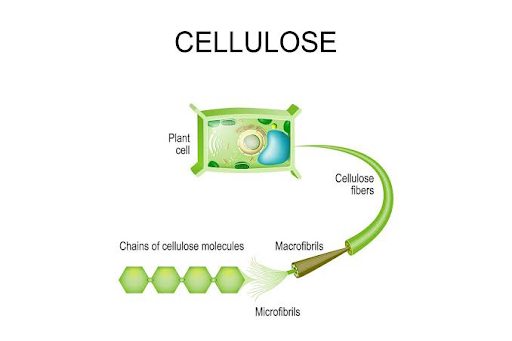Cellulose
Constitution of cellulose
1. Molecular formula is (C6H10O5)n.
2. Acid hydrolysis of cellulose gives 96% D-glucose. This indicates that cellulose is made up of D-glucose unit
3. From nitration & acetylation studies it is found that there are 3 free hydroxyl groups in each glucose unit
4. Complete methylation of cellulose followed by acid hydrolysis gives 96% yield of 2:3:6-tri-O-methyl-D-glucose (all the remaining glucose units) 0.6% of 2:3:4:6-tetra-O-methyl-D-glucose without any dimethyl glucose. These facts suggest that it is a straight linear open chain polymer of glucose units
5. The above hydrolysis products led to the following conclusions.
i. The formation of 2, 3, 6-trimethyl glucose indicates that in cellulose free OH groups are present on C2, C3 and C6. Hence in cellulose
the two glucose Units may be linked through C1 and C4. (if glucose units are present as
Pyranose) or through C1 and C5 (if glucose units are present as furanose). But since the cellulose is not easily hydrolysed, the glucose units must be in the form of pyranose rings. I.e. the two glucose units are linked through
C1 and C4.
ii. The yield (0.6%) of about 2, 3, 4, 6-tetra methyl glucose indicates that cellulose has a chain length of 100 to 200 glucose units.
iii. The failure to isolate any dimethyl-D-glucose indicates that cellulose is a linear polymer.
6. Acetolysis (simulatenous acetylation and hdrilysis) of cellulose with a mixture of acetic anhydride and sulphuric acid gives cellobiose octaacetate. This suggests that cellulose that is composed of cellobiose units.
7. Gentle acidic hydrolysis of cellulose, gives in addition to cellobiose cello-triose, tetrose, -pentose, - hexose and - heptose and in all of these the C1-C4 links have been found to be β.
8. Since cellulose forms colloidal solution in the solvents in which glucose is soluble, the cellulose is a very large molecule. Also since cellulose forms fibers (example rayon) it is a linear molecule which has been confirmed by
X-ray analysis.
9. Thus, on the basis of above point’s cellulose may be assigned the following structure
Conformation of Cellulose
10. The cellulose molecule is not planar, but has a screw-axis, each glucose unit being at right angle to the previous one. The absence of free rotation the C-O-C link due to steric effect and the close packing of atom give rise
to a rigid chain molecule.
11. The chain length or molecular size is achieved by determining the molecular weight of the cellulose which has been found to be 100 to 200 glucose units.The method consists in complete methylation, followed by hydrolysis with dilute acid to cleave all the glycosidic linkages. Thus the non-reducing end will give
2, 3, 4,6-tetra-O-methyl-D-glucose,
while the all other units will be hydrolysed to 2, 3, 6-tri-O-methyl-D-glucose is given below:
The two methylated sugars obtained by hydrolysis were separated by vacuum distillation. Hence, by knowing the percentage (or ratio of tetramethyl / trimethyl derivative) of the tetramethyl derivative, the length of the chain is estimated. The results obtained by this method indicate the presence of a chain having 100 to 200 D-glucose.




Nice
ReplyDeleteGood
ReplyDelete